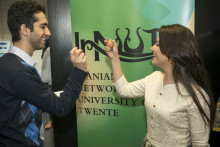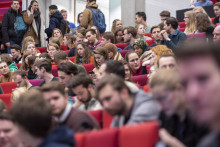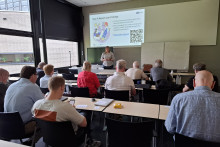3, 2, 1… Happy New Year! Everyone jumps from their seats, hugging, kissing, dancing, greeting each other with well-wishes for the new year to come. At 11.30 this morning the Equinox – the exact moment the sun passed over the equator – heralded the start of the Persian New Year Nowruz. This commemoration, hosted annually on campus by the Iranian Network at the UT (IrNUT), is a celebration of spring, rebirth, luck, and prosperity. Embedded deep within Iranian culture, Nowruz is a time for nostalgia and revering one’s elders.
Tradition
‘During the two weeks of Nowruz, families are reunited,’ says Emad Shahroodi, IrNUT board member and master student at the UT. ‘It is a tradition that the entire family, sometimes up to 100 people, will visit the homes of their eldest relatives. There is no need for an invitation, just show up and you are greeted with tea, nuts, and small gifts such as coins or confetti – which are small cakes that are very complex to prepare. They are considered a delicacy and are often only served during special events such as this.’
Family
This cherishing of one’s family and keeping with tradition was quite apparent, for as soon as the clock struck 11:30, sons and daughters were phoning their parents from halfway across the globe. Many other endearing rituals took place during the event, such as the tradition of smashing two eggs together, hoping that yours is the lucky one that doesn’t crack. Traditional Persian songs about love and Spring were sung, accompanied by traditional instruments such as the sitar, daf, and ney. Most significant, however, was the Haft-seen table adorned with symbolic artefacts representing the New Year.
Symbolism
‘The Haft-seen table is present at all Nowruz celebrations, and it signifies the seven things that begin with the letter S in the Persian language. Traditionally, we will place things such as grass, garlic, apples, and fruits to represent Spring and new life. There are also colored eggs, representing fertility, and coins representing wealth. Finally there is a mirror, to represent light and truth: a mirror never lies, it always shows things as they are,’ explains Shahroodi. ‘Sometimes non-symbolic items are also placed on the table, such as a goldfish, which are present simply for its nostalgic value.’
Nowruz itself is inherently symbolic, its origins stemming from an ancient Persian myth. ‘There is a myth,’ continues Shahroodi, ‘that there once was a great king, and the day that this king conquered his throne was called Nowruz. In this king’s palace was a great hall, and one day each year the Equinox would cast shadows across the entire hall. That is the legend behind Nowruz.’







